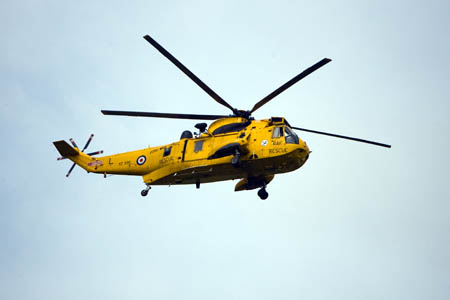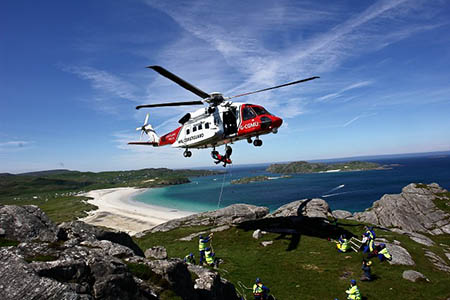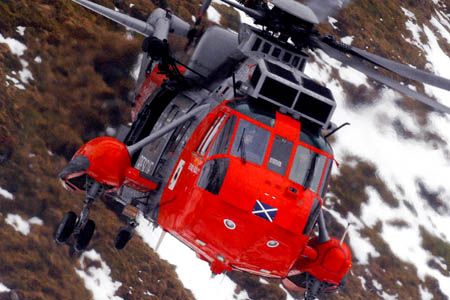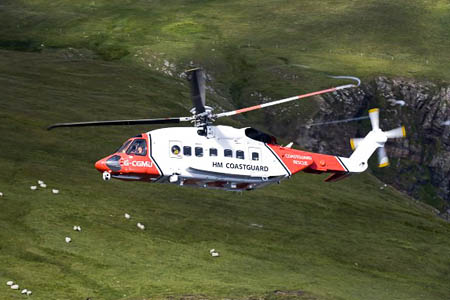Britain’s privatised search and rescue helicopters will carry the livery of HM Coastguard when the service is introduced in 2015.
Although the aircraft, which are expected to be used extensively in mountain rescues, will be operated by Bristow, they will carry the red and white colours of the Maritime and Coastguard Agency.
The MCA currently operates helicopters from Lee-on-Solent, Sumburgh in Shetland and Stornoway on Lewis.
The Stornoway helicopter is used regularly on mountain rescue callouts in the Western Isles and north-west Scotland, supporting voluntary mountain rescue teams in those areas.
The present military search and rescue service provided by the RAF and Royal Navy will be phased out between April 2015 and April 2017.
The change will mean an end to the familiar yellow RAF and red and grey Royal Navy Sea King helicopters which have rescued countless walkers, climbers, mountaineers, mountain bikers and other enthusiasts from the uplands of the UK.
Details of the new service were presented to Mountain Rescue England and Wales representatives in July. Writing in the current edition of Mountain Rescue, the membership magazine of the organisation, John Hulse said rescuers were told about two-thirds of crew members of the new helicopters are expected to be ex-military.
The new service will use Sikorsky S92 helicopters similar to those based currently at Stornoway and smaller Agusta Westland AW189 aircraft, which have yet to be manufactured.

The yellow RAF Sea Kings will be withdrawn from 2015, starting with those at Lossiemouth and Leconfield
The Sikorsky and Agusta helicopters will have a similar cruising speed to the Sea King’s 125 knots (144mph) though they can be pushed to about 190mph.
The S92s will have a range of 288 miles on the outward and return journey, with a capability of 30 minutes at the scene.
AW198s can fly 219 miles in each direction with half-an-hour at the rescue site.
The Department of Transport, responsible for overseeing the transition to the privatised service, said it was designed to reduce average flight time for search and rescue missions from 23 minutes to 19 minutes.
All current RAF and Royal Navy search and rescue bases will close, with new Coastguard ones opening at Inverness, Humberside, Manston, Newquay, Cardiff, Caernarfon and Prestwick, a short hop across the asphalt from the present HMS Gannet.
The existing Lee-on-Solent, Stornoway and Sumburgh Coastguard bases will remain.
Mr Hulse said: “RAF Mountain Rescue Service teams report that the downdraught from the S92 is significantly worse than that of the Sea King.
“As a consequence, all team members carry protective glasses when working with the S92.”
Mr Hulse said that Scottish mountain rescue teams which worked with current Bristow helicopters from Stornoway had provide generally favourable reports.
In April, the Mountain Rescue Committee of Scotland welcomed the prospect of the new helicopter service.
The chair of the MRCofS Jonathan Hart said: “Scottish mountain rescue very much welcomes the announcement of the Bristow contract and the opportunity to introduce new, more reliable aircraft into mountain rescue service.
“I am particularly pleased with the addition of updated and improved S92s and the introduction of the AW189, thus providing team leaders a range of aircraft that they can request depending on the nature of the rescue they are responding to.
“With approximately 60 per cent of all Scottish mountain rescues occurring within a 30-minute flight of Fort William, the new announcement that there will be a base at Inverness airport is particularly good news for all mountain users.
“The new aircraft are faster, have the most modern avionics and communications systems and importantly will transfer casualties to the right hospital in a shorter time. These improvements in service are all very welcome.”
Mr Hart said that military search and rescue crews deserved a huge thanks for their service. “Scottish mountain rescue owes an enormous debt of gratitude to the SAR crews over the years from both the Royal Navy and the RAF.
“They have provided an incredibly high level of support to the mountain rescue teams across the country and are held in very high esteem both by rescue team members and thousands of casualties and missing persons whom they have recovered.”
The coalition Government announced in March that the Texas owned Bristow Helicopters had been awarded the £1.6bn contract for search and rescue helicopters.
The company’s chief executive William E Chiles said: “This award will employ 22 of the world’s most technologically advanced and safest helicopters which will dramatically improve the capability to save lives and significantly reduce the UK Government’s costs for the next decade.”



Owain
03 November 2013Bi-lingual livery & signage (Welsh - English) on any choppers operating in Wales please. Diolch
Jim Fraser
07 November 2013You know, I'd love to think that we lived in a country where we could have Welsh, Kernow, Gaelic, Norn on aircraft at the appropriate bases. Deployment flexibility works against this. However, I tend to believe that the greatest impediment is the nit-picking civil service.
If you had seen what all the bidders had to put up with to get their bids for this contract examined you wouldn't ask. If we had to get Welsh as well as English then we probably wouldn't have helicopters until 2020. It would have taken until 2015 just to get a decision about whether they would be in the same font.
Sheepy
25 November 2013Don't forget Urdu!
CoastalJoe
16 August 2014The Government has been very vague about how it assessed the replacement of Seaking military cover.
The new aircraft maybe a little faster but have less than half the operational range and lower weight capacity.
There will be a nearly 50% reduction in available aircraft with the loss of Military involvement.
Whilst I agree that Seaking is old & expensive to maintain, the fact remains that the computer based model of SAR requirements failed to take into account the need for more aircraft to cover range reduction gaps.
No matter how fast these aircraft are, they cannot be in two places at same time.
R.F.Cook
25 July 2015I live under the flight path to Lydd airfield.your helicopters r flying day & night.
Why cN they not fly down the coast and then into Lydd airfield this will be less disturbance to all residents of Littlestone,Kent?
Common sense
15 November 2016Don't live near an airport....
Rescue helicopters don't do 9-5.